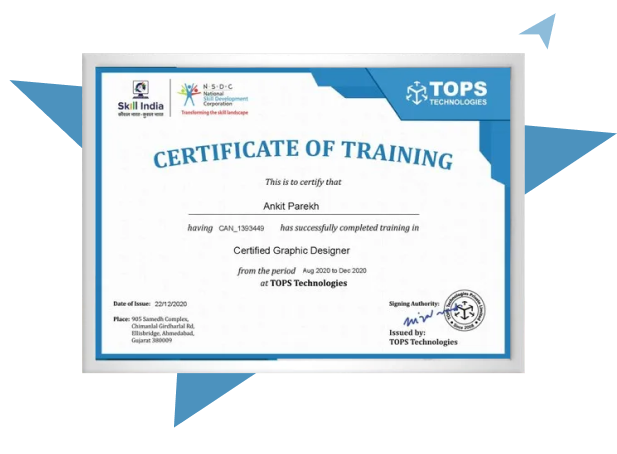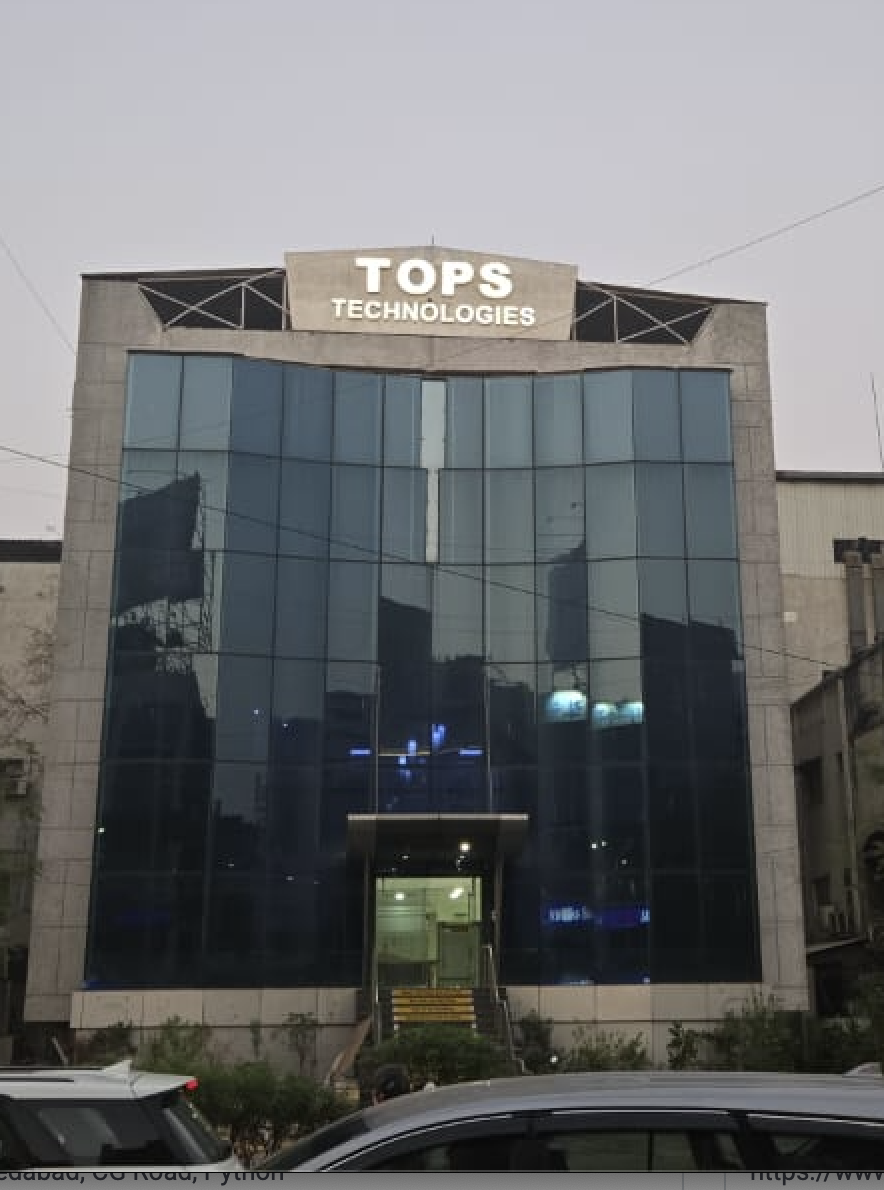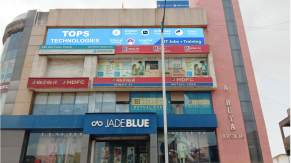Our Facts and Figures
Want to be a versatile developer? Learn Full Stack Development. You'll gain front-end and back-end development expertise with TOPS Technologies' comprehensive curriculum and hands-on training. Our limited student batches, Personalised attention, and industry tie-ups ensure a job-oriented approach. Join our Full Stack Development Course and take your career to new heights!
1 Lac+
Student Placed
3000+
Companies TieUp
19+
Offices in India
50+
Industry Courses
Get 100% Job Assistance by enrolling in Certified Full Stack Training Course
Key Highlights
Limited Students Batch
Personalised Attention
Highly Qualified Teachers
Flexible Batch Timings
Interactive Learning
Live Projects
Career Support
Job Oriented Training
Full Stack Development Course Highlights
Best Full Stack Developer Course with Placement Guarantee
The demand for Full Stack development courses in India is high because of the increasing number of startups in the country. There is a shortage of skilled developers in India and this has led to an increase in the demand for such courses, which are now being offered by many institutes.
According to a recent study by a well-known employability assessment company, there is a shortage of 1 million skilled workers in India. The study also found that there is a huge demand for Full Stack developers with over 5 lakh vacancies currently open across India. In fact, according to the study, more than 50% of Indian companies are looking for Full Stack developers and this number will only grow as time passes by.
The full stack development training enables students to acquire unique skills to build database-backed APIs and web applications. Once you complete full-stack training, you will be able to design and develop databases for software applications, create and employ database-backed APIs, and secure and manage user authentication and access control for an application.
The Full Stack Development Course is offered by TOPS Technologies, a prominent institution. We provide a thorough course that takes you from the basic to the advanced ideas of Full Stack programming. You can complete Full Stack Training at TOPS Technologies, where you'll learn how to create databases, integrate APIs, create secure user authentication, and other crucial components of building digital goods. In addition, you'll work on real projects, ace interviews with confidence, and land a position at a prestigious IT firm.
What is Full Stack Web Development?
Full Stack Web Development is a term used to describe the practice of being knowledgeable in both the front and back end of web development. Full Stack web developers are able to work on the client side, server-side, and database. They can work with a variety of programming languages, frameworks, databases, and operating systems. This is an important skill for any developer to have as it gives them more freedom to explore different types of projects.
Full Stack Web Development involves in-depth computer system applications comprising both frontend and backend development concepts. It includes the Presentation Layer (the front end), the Business Logic Layer (the backend), and the Database Layer. A full-stack developer works from the inception of a project to the launch of the final product.
A skill in high demand is Full Stack web development. Enrolling in a full-stack web development course with placement support can help you improve this skill. It is a necessity for every aspiring web developer. These courses will teach you how to build apps and software from scratch, which will improve your comprehension of how they work.
Full Stack Web Development Courses teach HTML, CSS, JavaScript, and PHP programming languages. You'll also learn how to use frameworks like Django and Ruby on Rails. For people who want to work in IT or start their own internet business, this can be a fantastic career choice.
Due to the high demand for the best full-stack developer course with placement right now, there is a great need for qualified people to fill the gap. A few justifications for selecting a Full Stack development course with placement are as follows:
- The growing need for more developers
- The short duration, high employment rates, and flexibility and simplicity of the courses
Benefits of Full Stack Development
Full Stack development is a great way for developers to sharpen their skills and become more versatile in their profession. It also helps them learn new things, which is always an advantage in any industry.
The benefits of learning Full Stack Development are numerous. It’s a method that allows developers to create and manage their own projects from start to finish, with the help of all their skill sets. This means that they can take care of everything from design to development.
Work on Front-end and Back-end Development
One of the most important skills in today's digital world is knowing how to code. It is no longer enough to know just HTML and CSS, knowing how to code in at least one language is essential.
The best Full Stack development courses with placement help make developers proficient in front-end and back-end development. They have a good understanding of how things work from the point that the user interacts with their website until the data is sent back to their database.
Work on Both the User Interface and Server-Side Code
Full Stack development is the process of developing a product by creating both the user interface and server-side code. You will need to have a good understanding of both the front end and back end to do this because you will be responsible for the entire product.
In order to be successful in this field, you will need to have a good understanding of how web pages are put together and how they work. You also need to know how servers work and what languages are best for server-side code.
Understanding How Each Layer Works
A lot of developers are not limited to just one skill. They are often skilled in multiple programming languages and can work on the user interface and server-side code.
Learning Full Stack development gives the ability to developers to understand how each layer of a website works and communicate with each other. This knowledge is very useful for a developer because it helps them in understanding how each layer works and communicates with each other.
Develop a Deeper Understanding of the Codebase
Learning Full Stack Development helps in developing a deeper understanding of their own codebase, which enables them to debug and fix bugs more efficiently. They also develop a better understanding of the business side of things, as they are able to see what is going on behind the scenes.
Full Stack Developers can find themselves in any field from web development to robotics. This is because the job requires them to have deep knowledge and understanding of both the front-end and back-end aspects of coding.
Identify Problems Before They Happen
Full Stack development is a relatively new concept. It is a job role that involves developing the ability to identify problems before they happen.
The developer's responsibility is to ensure that the code they write will be able to handle any kind of situation that may occur in the future. This includes everything from bugs and errors, to complex data structures and code execution patterns. Thus learning Full Stack Development helps them in developing the ability to identify problems before they actually happen.
Industries That Use Full Stack Development
A Full Stack developer has the ability to work on all aspects of a project, from designing the user interface, implementing business logic and data access layers, creating server infrastructure, and monitoring server performance.
The following industries use Full Stack developers:
- Finance
- Gaming
- Healthcare
- Nonprofit Organizations
- Education
By enrolling in a Full Stack Development Course, you may learn all you need to know to begin a career in these sectors. Visit our website or contact one of our specialists for more information on the Full Stack Course.
After Completing the Full Stack Developer Course : Job Roles, Salary
Full Stack web development course opens doors to a lucrative career in the IT industry. Understanding the process of web development positions you ahead of developers familiar with only one side of the concept. In addition, a Full Stack course is a critical element to landing a full-stack engineering job.
As a Full Stack developer, you handle the needs of an organization by offering creative solutions for user experience and helping businesses save time and money. With Full-Stack Developer Training, you become a go-to candidate for the back-end and front-end processes.
There are plenty of high-paying career opportunities where Full Stack training is useful:
- Software Developer
- Computer Systems Analyst
- Information Security Analyst
- IT Manager
- Computer Programmer
- Computer Network Architect
Software Developer: A Full Stack Software Developer is a person who has the skills to create the front-end and back-end of an application. They are also responsible for designing, programming, testing, and debugging. The salary of a Full Stack Software Developer is up to 17 lakh Indian Rupees (INR) in India.
Computer Systems Analyst: A computer systems analyst is a professional who analyzes the needs of an organization and then designs, builds and implements the computer systems that will meet those needs. Computer systems analysts are responsible for designing, implementing, and maintaining complex computer networks. They also design software applications to manage data. The work of a computer systems analyst can vary depending on the type of organization they work for. The salary of a Full Stack Software Developer is up to 8.1 lakh Indian Rupees (INR) in India.
Information Security Analyst: Information security analysts are responsible for protecting a company’s assets from cyber-attacks. They are usually responsible for handling a variety of tasks that include identifying and assessing risks, recommending solutions to mitigate risks, developing and implementing policies to protect sensitive data, and creating awareness among employees to protect data. An information security analyst in India could earn up to 12 lakh Indian Rupees (INR) per year.
IT Manager: An IT manager is a person in charge of overseeing the IT department and managing all the IT staff. The job role of an IT Manager is to keep all the hardware and software up-to-date, while also ensuring that they are secure. They also need to make sure that all staff members have access to the right resources and tools, as well as ensure that they have access to any training they need. The IT manager needs to take care of a number of other tasks too, such as monitoring network usage and purchasing new equipment. An IT manager in India could earn up to 25 lakh Indian Rupees (INR) per year. The IT Training Institute is a place where people can come to learn and become experts in the IT field. This is a place where people can go to learn about the latest trends in the field of IT.
Computer Programmers: Computer programmers are professionals who design and develop software that runs on computers. They are responsible for everything from the underlying code to its interface. The job of a computer programmer is to design, develop, test, and maintain software. They need to work with a number of different technologies and languages, so they need to be adaptable in order to keep up with the latest trends in the industry. The role of a computer programmer is complex as they need to be able to work with both hardware and software. They also need an understanding of mathematics, science, and engineering. Computer programmers in India could earn up to 15.1 lakh Indian Rupees (INR) per year.
Computer Network Architect: A Computer Network Architect is a person who designs and implements computer networks. They are responsible for the design, installation, and ongoing maintenance of computer networks. They also have to make sure that the network is secure and can handle any potential future needs. A Computer Network Architect needs to be able to work with different types of hardware such as routers, switches, firewalls, and wireless access points. They also need to know how to use a variety of software such as Cisco IOS or Juniper JUNOS. Computer Network Architects in India could earn up to 36.1 lakh Indian Rupees (INR) per year.
Why Choose Us for Full Stack Course?
TOPS Technologies offer you an opportunity to work on real-world projects with immersive content built by expert Full-Stack developers. With our tailored Full-Stack course, you will master the tech skills most sought-after by top-tier companies. Our experienced mentors guide you through the learning process by focusing on a one-on-one teaching approach. Learn at your own pace and reach your personal goals to start or change the path to a successful career in the IT industry. We offer a comprehensive Full Stack developer course with placement services.
What to Expect from the Best Full Stack Developer Courses?
The best Full Stack developer training should include instruction on programming languages and frameworks. The essentials of database management, web security, and web programming should also be under your belt. The course should also devote a lot of time to JavaScript and its frameworks, including Angular, React, and Vue.js.
There is a long and varied list of benefits. The many important benefits that Best Full Stack Developer Courses offer include
- Learning basic programming concepts
- Industry-Approved Certification
- Experience in the Industry
- Mastering both front-end and back-end skills
- Understanding how their work impacts the world around them
- Gaining a deeper understanding of the technologies they use
Who Can Enroll in the Best Full Stack Development Course?
If you're just getting started and want to learn more about the web development profession, this Full Stack Web Developer Course is for you. You'll learn how to use HTML, CSS, and JavaScript to build websites from the ground up. Anyone interested in learning more about web development and programming languages like HTML, CSS, and JavaScript should take this course. It makes no difference if you lack any prior programming or linguistic knowledge.
Our Full Stack course is designed for
- Computer science graduates
- Freshers looking to build a career in the IT industry
- Professionals looking to change their career path
- Candidates looking to acquire a Full Stack developer course with certification
- Anybody willing to learn back-end and front-end web development
If you want to build your career as a Full-Stack developer, you need to learn from the best of the best in the industry. We at TOPS Technologies offer complete guidance and the opportunity to work on real-world projects with immersive content built by expert Full-Stack developers. Our Full Stack Web Developer Course is tailored to build and master your tech skills most sought-after by top-tier companies. At TOPS Technologies, we focus on a one-on-one teaching approach, allowing the learner to learn the matter in depth. Learn at your own pace and reach your personal goals to start or change the path to a successful career in the IT industry. We offer a comprehensive full-stack developer course with placement services. Enroll in Our Full Stack Web Developer Course & Start Exploring Your Interests!
For those seeking a career in software development, TOPS Technologies provides excellent Full Stack Training. We also provide a full-stack developer online course.
Customized Corporate Best Full Stack Institute
For further inquiries regarding the TOPS Technologies Full Stack Web Developer Course, reach out to us at inquiry@tops-int.com or call us at +91 – 7622011173 for a free demo. You can also learn Full stack courses in Ahmedabad, Vadodara, Gandhinagar, Nagpur, Rajkot, and Surat
40%
Average Salary Hike
4.5 Lacs
Highest Salary
3000+
Hiring Partners
Join Our Free Upcoming Webinar
Skills you need to Become an Expert Data Analyst
11 Jul 2025, 02:00 PM
Trainer
Rahul Sanghavi CG
(Sr. Technical Trainer)
Learn the Website Hacks and Provide Better Security
11 Jul 2025, 03:30 PM
Trainer
Faruk Pathan
(Sr. Technical Trainer)
Motion Graphics and Animation in Design
11 Jul 2025, 05:00 PM
Trainer
Parth Patel
(Sr. Technical Trainer)
All About Full Stack Development
12 Jul 2025, 10:30 AM
Trainer
Anjali Patel
(Sr. Technical Trainer)
How to Create a Live Website + Internship
12 Jul 2025, 12:00 PM
Trainer
Anjali Patel
(Sr. Technical Trainer)
From Data to Decisions : AI in Smart Industries
12 Jul 2025, 02:00 PM
Trainer
Bhaumik Vyas
(Sr. Technical Trainer)
Career in Digital Marketing
12 Jul 2025, 04:30 PM
Trainer
Sanket Chauhan
(Sr. Technical Trainer)
Android UI Design with Kotlin
13 Jul 2025, 11:00 AM
Trainer
Prakruti Vyas
(Sr. Technical Trainer)
Full Stack Development Course Curriculum
Download Curriculum- C Language – Control statements (if, . else statements , nested if statement , switch statement) ,looping statements (for, while ,do .. while)
- C++ : Oops concepts (class, objects, inheritance , polymorphism , data abstraction, encapsulation)
- Html 5, Tags, Input Forms
- Css3
- Sql
- CRUD operations queries
- Select statements
- Where clauses
- oin queries
- HTML-(1 session)Basic HTML like What is Tags attribute property Form Tag HTML-HTML5 tags
- CSS (1) Selectors • Margin-Padding-display property • Create login-registration page
- Bootstrap (2) Grid Rows-Cols • Forms-Cards
- SQL-(MySQLi)(4)
- SQL Queries
- Normalization
- Joins
- Indexer
- Practical Examples 1) MySQL data types 2)Create Multiple Tables and perform the queries using Select, Update, Delete, Insert Where, Like, Group By, Having, Limit, Offset, Sub Query and Or, Not, In 3) Function and procedure 4) Trigger 5) Views 6) Primary a
- PHP array
- PHP expression
- PHP function
- PHP operations
- String Function
- PHP String
- Practical Example: 1)Display the value of the array 2) To Find the number of odd and even element in array. 3) Create associative array for user detail and display the user detail. 4)shifted all the zero in bottom up of the array
- HTTP Protocol
- PHP syntax
- PHP variable
- Super Global Variables
- Practical Example: 1) Create Multiple Tables and perform the queries using Select,Update,Delete,Insert Where,Like,Group By,Having,Limit,Offset,Sub QueryAnd ,Or,Not,In
- Conditions Events and flows
- If condition
- If else if
- Practical Example : 1)Make Simple Calculator 2) Find the current day and if it is Sunday than print happy Sunday
- Practical Example: 1) Restaurant food Category Program using Switch case Display Which Category and dish user 2) Using Ternary display age if it is greater than 18 3)Display Name Of the color which user selected
- Do While Loop
- For each Loop
- For loop
- Practical Example : 1) Create a script that displays 1-2-3-4-5-6-7-8-9-10 on one 2) Create a script using a for loop to add all the integers between 0 and 30 and display the total. 3)Write a PHP script using nested for loop that creates a chess board 4)Al
- Array Function
- Date-time function
- Header function
- Include require
- Practical Example: 1) Perform all the 2)In user define function: 3)Create calculator 4)Find factorial using recursion 5)Reverse string without function 6) Download file on button click
- SDLC OOPS :Object Oriented Programing Class – object Inheritance Polymorphism Encapsulation Abstraction Aggregation
- SQL : Importance of Database CRUD JOIN QUERIES
- Front-End Fundamental : HTML , CSS , JavaScript , Jquery
- ViewBag,ViewData,TempData 2 MVC Life Cycle 3 Razor Controls
- State Management 5 JavaScript,Jquery,Ajax 6 Web Api
- EDM & LINQ & Net Differences practical
- OOPs Concepts
- Class
- Object
- Extends
- Overloading
- Abstraction interface
- Constructor
- Destructor
- Magic Methods
- Scope Resolution
- Traits
- Visibility
- Type hinting
- Final keyword
- Email security function
- File handling
- Handling emails
- MVC Architecture
- Practical Example: Implementation of all the Oops Concept
- Connection with MySQL database
- SQL injection
- Practical : 1) Take Project Definition 2) Exception handling with try catch for database connection and all 3) Server- side Validation while Registration using Regular expressions. 4) Send mail while registration
- Session and cookies
- File upload
- PHP with MVC Architecture
- Insert, Update, Delete MVC
- Practical Example: 1) Apply session cookies concepts 2) File uploading and downloading 3) Bootstrap data-table Pagination
- Java script
- JQuery
- JQuery Events
- JQuery Validation
- Practical Example: 1)Alert, Prompt, Confirm 2)Create calculator 3)Create slideshow 4)Validation using JavaScript 5)Hide show using jQuery
- PHP and Ajax
- AJAX (crud)
- Regular Expression
- Practical Example :1) Event Examples (Onblur,onkeypres) 2)Regular expression 3) Create dependent drop down Pagination using ajax jQuery in MVC Project Insert Files using Ajax
- Payment Gateway Integration
- -> Create API With Header -> API with Image Uploading
- Practical Example: Payment Gateway Implement on MVC Project
- -> SOAP and REST AP, Create API for insert, update and delete
- Product Catalog
- Shopping Cart
- Web Services
- Practical Example: Create Web Services for MVC Project Integration of API in Project
- Installing Laravel
- Artisan CLI ( command-line interface )
- Laravel Directory Structure
- Configuring a new Laravel project
- Artisan command to generate boilerplate code for a controller
- Basics of laravel—— > Routing
- Controller
- Middleware
- Request
- Response
- HTML Template to Laravel Blade Template
- HTML Template to Laravel Blade Template———- > Template inheritance
- Master layout
- Extending the master layout
- Displaying variables
- Blade conditional statements
- Blade Loops
- Executing PHP functions in blade
- Displaying Your Views
- Creating and using a basic views
- Loading a view into another view/nested views
- Adding assets Integrating with Bootstrap
- Introduction
- Requirements for running migrations
- Artisan migration command
- Migration structure
- How to create a table using a migration
- Laravel migration rollback
- Database Seeding
- Migrations for our project database Pagination
- Creating contact us form
- Validating user input
- Sending email
- Creating a file uploader
- Validating a file uploader
- Creating a custom error message
- Laravel Collective—— > Installation
- Opening A Form
- Form Model Binding
- Form controls
- Custom macros
- Introduction
- Creating a basic controller
- Creating a route using a closure
- Making the controller RESTful
- Using route groups
- Building a RESTful API with routes
- Rest API with Passport Authentication
- Event
- Queue
- Task Scheduling
- Eloquent ORM and Models—— > Naming conventions
- Table name and primary keys
- Timestamps
- Eloquent ORM INSERT, READ, UPDATE, DELETE
- Relationship
- Using models in controllers
- Displaying data from models in views
- Creating and Using Composer Packages———- > Downloading and installing packages
- Using a basic Shopping Cart package in our project
- socialite
- Using Ajax and jQuery—– > Getting data from another page
- Setting up a controller to return JSON data
- Creating a Jquery, AJAX comment system
- Security & Session—— > Using Security Sessions Effective
Our TOPS Training Centers in India
Course Key Features
Skills Covered
Job Roles
Get Training Certificate by Government
Recognized NSDC/Skill India

- National Skill Development Corporation
- Supported by the vision of PM Shri Narendra Modi
- Certification by NSDC SkillIndia
- Valid for all Jobs and College Training
- International Recognition

FAQ
The cost of a Full Stack Development Course may vary depending on the length of the program and the specific college providing it. Depending on the organization, costs could range from a few hundred dollars to tens of thousands.
Make sure the programming course you're thinking about falls within your budget. Depending on how long a program lasts and whether it's a Bootcamp or an online course, the cost may vary greatly.
Yes, you can enroll in the Full Stack live project training offered by TOPS Technologies. We give our learners the best instruction and preparation in this area.
Please contact us right away if you have any questions about our Full Stack Development Course or our Full Stack Live Project Training. We are pleased to discuss your options with you if you have any queries.
After mastering Full Stack web development, you might consider looking for employment. Excellent Full Stack Developers in India, which is home to some of the best and most well-known businesses, have a variety of possibilities.
If you are confident in the abilities and qualifications you obtained at Full Stack Institute, the next step is to send your CV and portfolio to agencies and businesses. It might be a good idea to attend interviews on the other candidates' behalf. Last but not least, keep up the good job and maintain your optimism even if you don't hear back right away; eventually, you'll have a chance.
With a Full Stack developer course that prioritises placement, TOPS Technologies is the premier Full Stack institution. Anyone interested in working in the software development industry should definitely take this course. The Full Stack training course contains comprehensive explanations of the concepts and methods used in Full Stack web development. In order to help students get employment in Full Stack web development, the course also provides placement support.
Recent studies and surveys have revealed that the usual annual remuneration for a Full Stack Developer may go up to Rs. 17 lakhs. However, the pay scale may vary based on each applicant's level of expertise and the Full Stack Institute where they received their education.
You ought to consider consulting TOPS Technologies if you want to prepare for your forthcoming Full Stack Developer interview effectively. Our team of specialists can help you achieve the results you want thanks to their years of experience in the sector.
In addition to offering you access to our most recent tools and materials, we also provide basic Full Stack training programmes so that you may stay current with the most recent methods. Our team is also available to assist you and respond to any inquiries at any time.
Get in contact with us immediately to learn more about our Full Stack Developer interview preparation services!
Skills and qualities that a Full Stack Developer must possess after completing a Full Stack Course:
- Strong analytical skills
- Attention to detail
- Good problem-solving skills
- Able to work in a team environment
Interview Questions
Full Stack Development refers to developing software applications encompassing all application stack layers, from the user interface to the server-side logic and the database. A Full Stack Developer is a software engineer with the skills and knowledge to work on all aspects of an application, including front-end development, back-end development, database design, and server configuration.
A Full Stack Developer deeply understands multiple programming languages, frameworks, and tools and can use them to build high-quality, scalable, and maintainable applications. They are proficient in technologies such as HTML, CSS, JavaScript, React, Angular, Node.js, Python, Java, SQL, and NoSQL databases.
Full Stack Development has become increasingly popular. It enables developers to work on various tasks and contribute to different application parts, resulting in faster development times and more efficient workflows.
Full Stack Developers can also create more robust and scalable applications as they have a holistic understanding of the entire application architecture.
A Full Stack Application is a software system with front-end and back-end components that provide a complete user experience. The front-end component handles the user interface, while the back-end component handles the application's business logic, data storage, and processing. Here is a breakdown of the key components of a Full Stack Application:
• Front-end: The front-end component is responsible for presenting the application's user interface to the user. It typically includes HTML, CSS, and JavaScript, which are used to create and style the user interface. Popular front-end frameworks include React, Angular, and Vue.
• Back-end: The component handles the application's business logic and data storage. It typically includes a server-side language such as Java, Python, or Node.js, which handles requests from the front end and interacts with a database.
• Database: The database is responsible for storing the application's data. Popular databases include MySQL, PostgreSQL, and MongoDB.
• Middleware: Middleware is software that provides common services and capabilities to the application, such as authentication and security. Popular middleware includes Express and Passport.
• Deployment: The deployment component is responsible for deploying the application to a server or cloud-based platform, such as AWS or Azure.
Full Stack Development involves multiple layers responsible for building and maintaining an application. Here are the different layers of Full Stack Development:
• Presentation layer: This is the layer responsible for an application's user interface (UI). It includes technologies like HTML, CSS, and JavaScript, which create and style the UI. Popular front-end frameworks include React, Angular, and Vue.
• Application layer: This layer includes the server-side code that processes requests from the front end and performs the necessary computations. Technologies used in this layer include Node.js, Java, Python, Ruby, and PHP.
• Database layer: This layer is responsible for managing the storage and retrieval of data used by the application. Popular databases include MySQL, PostgreSQL, MongoDB, and Redis.
• Infrastructure layer: This includes the hardware and software infrastructure to host and run the application. It includes cloud platforms like AWS, Azure, or Google Cloud Platform and configuration tools like Docker and Kubernetes.
• Middleware layer: This layer includes software that provides common services and capabilities to the application, such as authentication, logging, and security. Popular middleware includes Express, Passport, and Mongoose.
REST (Representational State Transfer) is an architectural style that defines a set of constraints to create web services. RESTful Web Services are web services that follow these constraints and use the HTTP protocol to interact with other systems. They provide a simple and standardised way of accessing and manipulating resources over the internet.
Here are some features of RESTful Web Services:
Stateless: RESTful Web Services are stateless, meaning that each request from a client to a server contains all the necessary information to perform the request. The server does not need to maintain any state about the client.
Resource-oriented: RESTful Web Services are resource-oriented, using unique URLs to represent resources clients can manipulate.
CRUD Operations: RESTful Web Services allow CRUD (Create, Read, Update, Delete) operations to be performed on resources using the standard HTTP methods (POST, GET, PUT, DELETE).
Uniform Interface: RESTful Web Services provide a uniform interface for clients to interact with resources using standard HTTP methods, headers, and response codes.
Cacheable: RESTful Web Services are cacheable, meaning clients can cache responses to improve performance.
CORS (Cross-Origin Resource Sharing) is a security mechanism that allows resources, such as web fonts, images, and JavaScript, to be requested from a different domain than the one that served the original resource.
CORS protects web servers from unauthorised access by web applications that run in a browser and make requests to different servers.
Configure the server to include the necessary headers in the HTTP response to enable CORS. The headers are:
Access-Control-Allow-Origin: This header indicates which domains are allowed to access the resource. It can be set to "*" to allow any domain or a specific domain.
Access-Control-Allow-Methods: This header indicates which HTTP methods are allowed to access the resource.
Access-Control-Allow-Headers: This header indicates which headers are allowed in the HTTP request.
The exact steps to enable CORS to depend on the server technology being used. To enable CORS, you can add these headers to the server's HTTP response using server-side code or a server configuration file.
For example, you can add these headers in Apache using the "Header" directive in the server configuration file.
Latest Blogs
Transitioning into Full Stack Development: A Caree...
Embarking on a career in full-stack development offers a rewarding pathway in the tech world. Whethe...
View full BlogHow can I switch from front-end to full stack deve...
On the other hand, Full Stack Development is a broader domain that covers both the front-end and bac...
View full BlogFull Stack Developer Interview Questions
By investing your time in these Full Stack Interview Questions and Answers, you're not just preparin...
View full BlogRoadmap To Become a Full Stack Developer & The Bes...
A full stack development course in Ahmedabad can be a game-changer, particularly in India, where the...
View full Blog








